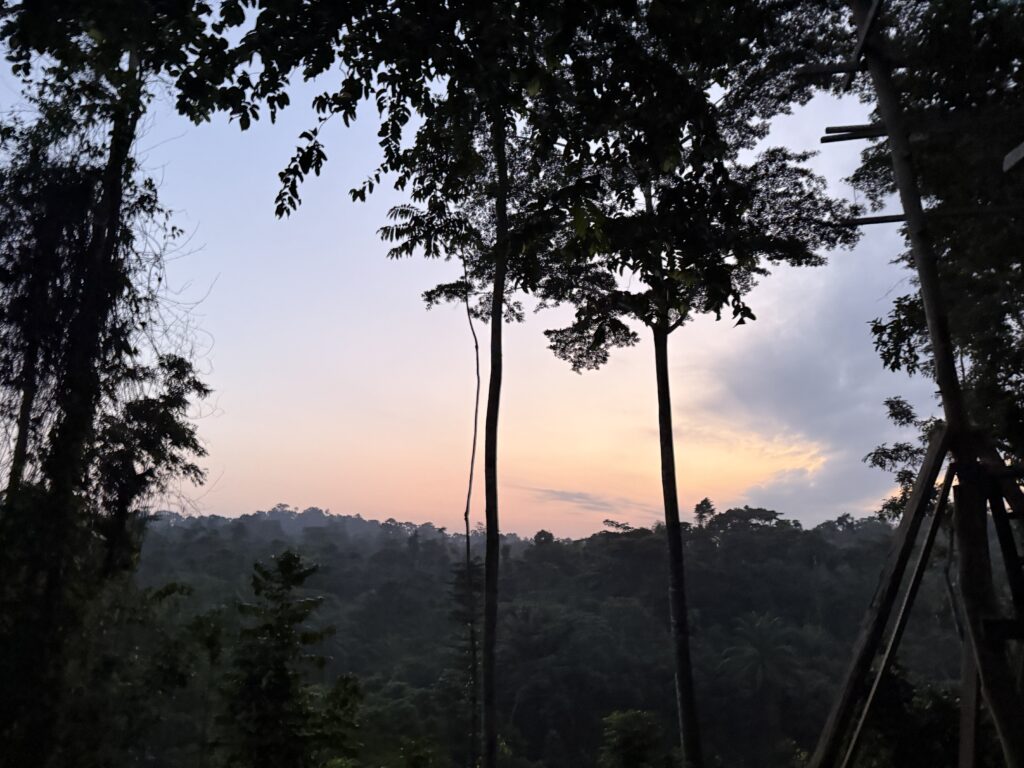
Sunset in Kakum National Park
As I prepared to study abroad, I had so many thoughts and expectations. Going to Ghana was not something I ever anticipated being a part of my academic and personal journey, but it ended up being one of the best and most valuable experiences I could have ever hoped for. As I reflect on my trip, I want to use my experience to help others achieve similar experiences for themselves. As a result, I want to give a few pieces of advice for preparing to study abroad.
First off, I would like to discuss the most prominent feature of preparing to travel abroad: packing. My experience took place in Ghana, so some of the advice here may be specific to conditions similar to my own, but the overall guidance is appropriate for any destination or program. To do this, I will provide a packing list with items and advice for how to determine what to bring and what to leave behind. While reading this packing list, keep a few important things in mind. Firstly, make sure all items follow airport/travel policies, and any liquids that are over the 3.4 fl oz limit are packed in a checked bag. Also, how much you do or don’t pack depends largely on how much luggage you can bring and how much you want to return with (make sure you leave some space for bringing back souvenirs/items acquired during your trip). For my trip, luggage space was limited, so I did my best to limit how much I packed, but if you have more space, feel free to pack more optional items! Finally, always follow the provided packing list that your instructor will provide. This list is a useful tool, but it does not address specific needs that you may have depending on your specific destination.
Packing List
Clothing – Things to take into consideration: cultural customs and modesty, climate and weather (lightweight material is more suitable for humid/hot regions), laundry schedule/availability (how many days’ worth of clothing should you pack?), and packability (how much space is each item going to take?)
- Light pullover/sweatshirt for airports (should fit in your carry-on)
- Swimsuit + cover-up (I would recommend 2 swimsuits, preferably with at least one being relatively modest)
- Jacket or poncho
- Shoes (these will vary depending on your specific destination. For example, you may need an extra pair of sandals for beach wear, or mostly closed-toe shoes in areas where venomous wildlife or soil-borne pathogens are common)
- At least one pair of tennis shoes/sneakers (preferably one pair for outdoor activity and another for regular/indoor wear)
- Sandals (at least one pair)
- Shower/house shoes (optional – depends on living arrangements)
- Underclothes (be sure to pack according to how often you will be doing laundry, but don’t overpack – I would suggest packing an extra three days of these items in case of emergency)
- Underwear
- Socks
- Bras (sports/active as well as regular)
- Pants
- Leggings/sweatpants (comfort wear)
- Long pants (jeans, cargo pants, slacks, dress pants, etc.)
- Shorts/skirts (athletic and casual)
- Tops
- Athletic wear
- Casual/everyday
- Professional blouse/dress shirt
- Dresses/Rompers
Safety and Documents – Make sure that you also have a plan for where to safely keep/store these items during your travel
- Passport
- Holder (optional)
- Other forms of identification (depends on specific travel destinations and requirements, but generally it is good to bring a form of federal identification, the easiest option for most being a driver’s license)
- Travel Visa – this is not necessary for all destinations; check! Also, be sure you meet all requirements and have all the required documentation and visa for your destination country. I recommend starting this process at least 3 months before your departure because of the varying time this process can take.
- Wallet – will hold your documents/ID, cash (the amount depends on your destination and planned activities, reach out to your advisor or program coordinator if you are unsure of how much is appropriate), and at least one credit card (make sure to check before you leave that you get a card without international fees)
- Any school-provided insurance or safety identification cards (for UA, this is the International SOS card that all students obtain during orientation)
- Bug spray (I recommend sprays with DEET, especially for those traveling to areas with dense bug populations and vector-borne diseases)
- Sunscreen (spray and lotion, at least SPF 30, but 50+ is ideal)
- First aid kit (specific contents will vary, but try to minimize size/weight because you will want to be able to take this everywhere with you)
Hygiene – This is only a general guide; be sure to pack anything you need or use daily, even if it is not mentioned here
- Makeup/skincare items (take into account the climate; you may want to adjust your routine depending on the humidity/sun exposure)
- Toothpaste + toothbrush
- Deodorant
- Hairbrush/comb
- Hair products and accessories (hair ties, headbands, clips, etc., especially for warmer climates)
- Tide pen or other stain remover
- Medications
- Prescribed medications
- Prophylactic medications (i.e., Malarone or Mefloquine if you are traveling to areas with a high risk of Malaria)
- Allergy medicine (optional)
- Pain relief medicine (Ibuprofen, Aleve, Advil, etc., use what you are familiar with and will not interact with any other medications you may take)
- Antacids/digestive medication (optional)
- Antibiotics (optional – may be prescribed and given before travel if you are going to an area with high transmission rates of communicable diseases)
- Motion sickness medication or patches (optional)
- Towel (preferably one that can be used as a shower/bathroom towel or beach towel to conserve space)
Miscellaneous– This is a general guide; not all of these will apply to your trip, and there may be some items not listed that will. For more individualized suggestions, try visiting independent travel blogs or guides online that are specific to your destination!
- Travel adapter and charging cords (different regions use different power sources; make sure you have an adapter that will allow you to charge any electronics or plug in any devices you may need)
- Portable power bank (optional)
- Travel pillow/blanket (optional)
- Headphones/earbuds
- Journal or notebook
- Sunglasses
- Small snacks/food for travel (optional)
- Hydration packets (optional)
- Laptop or other electronic device (optional, depending on the structure of the program; be sure to find out beforehand whether you will need to complete assignments while abroad)
Preparation and Expectations
While deciding what items to take (or leave behind) is a key aspect of the preparation process, determining what mindsets and expectations to bring with you is equally important. One especially useful way to do this is to create a schedule, not just of actual events in the program, but also of your own routines and habits. Knowing that you will have time to do the things that matter to you, whether it be self-care or talking with friends and family back home, is helpful when you are thrown into a completely new environment and routine than what you are accustomed to. Along this same line, make sure you also know the trip schedule. Knowing what to expect will greatly help reduce unnecessary stress and anxiety around the activities. Also, when planning your personal schedule during the program, account for some downtime/free time. Just because you are full of energy and anticipation while planning your trip doesn’t mean you won’t need to rest and recharge while you are there. Exhausting and stretching yourself too thin prevents you from maximizing your enjoyment and engagement, so be sure to account for occasional breaks when planning how to spend your time!
In addition to mentally preparing yourself and your expectations, it is also important to physically prepare for your trip. Before departing, be sure to visit your doctor and tell them about your planned trip. They can help you manage your health before and during your time abroad, providing appropriately timed and dosed prescriptions for any medications you may take, educating you on risks or diseases endemic to your destination region, and even potentially referring you to a travel doctor or pharmacist who is capable of providing any medications or vaccinations recommended/required for your destination. Depending on your destination, you may be required to receive certain vaccinations before your departure, so be sure to consult the CDC page on travel health and talk to your doctor about any vaccines you may need. Along with visiting your general practitioner or travel doctor, it is also a good idea to visit a counselor or therapist. Even if you do not regularly attend therapy, seeing a mental health professional can be a useful tool not only for daily life but also in preparing for your experience abroad. Most people are aware that they will experience some degree of stress in an unfamiliar environment, such as ‘homesickness’ or ‘culture shock’. However, many people are unaware that this stress can be reduced by simple tactics and coping mechanisms that can be learned through counseling and therapy. As a result, seeing a mental health professional, even for a single session or appointment, can be a key step in the process of preparing to study abroad.
Final Tips and Advice
At the end of the day, while there is no perfect way to prepare and pack for studying abroad, there are several beneficial habits and actions you can take to improve your experience. While everything discussed in this article is important and relevant to studying abroad, perhaps the most important thing to remember is that not everything will go according to plan – and that’s okay. You can do everything right, pack every item you will need, have everything in order, and develop the skills to handle the stress of the experience, but inevitably, something at some point in your experience will deviate from your expectations and plans. When this happens, it isn’t a reflection of your preparation or capability; it’s simply a different opportunity than what you expected, and knowing how to react and process these situations will determine the outcome. In the end, your experience is determined by what you make of it, and learning to accept and overcome the inevitable challenges and unexpected obstacles is the best way to prepare for your study abroad experience.
